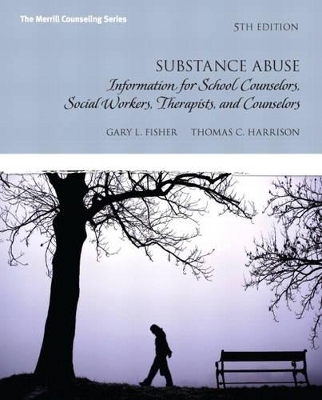
Substance Abuse
Pearson
978-0-13-315541-9 (ISBN)
- Titel ist leider vergriffen;
keine Neuauflage - Artikel merken
Packages
Access codes for Pearson's MyLab & Mastering products may not be included when purchasing or renting from companies other than Pearson; check with the seller before completing your purchase.
Used or rental books
If you rent or purchase a used book with an access code, the access code may have been redeemed previously and you may have to purchase a new access code.
Access codes
Access codes that are purchased from sellers other than Pearson carry a higher risk of being either the wrong ISBN or a previously redeemed code. Check with the seller prior to purchase.
-- An overview of substance abuse for generalist students, prospective mental health professionals, and allied professionals.
Providing a comprehensive overview of the substance abuse field, Substance Abuse: Information for School Counselors, Social Workers, Therapists and Counselors, Fifth Edition combines the accessible writing style and succinct, practical topical coverage that have made it a market-leading resource for generalist students, prospective mental health professionals, and allied professionals.
Continuing to cover basic pharmacology, models of addiction, assessment and diagnosis, cultural issues, intervention, treatment, recovery, support groups, children and families, other addictions, prevention, and confidentiality in its applied and concise style, this latest edition of Substance Abuse contains expanded coverage of screening and brief interventions, recovery oriented systems of care, spirituality and other current topics as well as a new chapter dedicated to motivational interviewing.
0133155412 / 9780133155419 Substance Abuse: Information for School Counselors, Social Workers, Therapists and Counselors Plus MyCounselingLab with Pearson eText
Package consists of:
0132613247 / 9780132613248 Substance Abuse: Information for School Counselors, Social Workers, Therapists and Counselors
0133036766 / 9780133036763 NEW MyCounselingLab with Pearson eText -- Standalone Access Card -- for Substance Abuse: Information for School Counselors, Social Workers, Therapists and Counselors
Gary L. Fisher is Professor in the College of Health Sciences at the University of Nevada, Reno. He was the founder and first director of the Center for the Application of Substance Abuse Technologies where he developed undergraduate, graduate, and continuing education activities for addiction counselors, prevention specialists, and allied professionals. Dr. Fisher’s career has spanned 38 years and includes work as a private practice clinician and a public school psychologist. In addition to this textbook, he is the author of Rethinking Our War on Drugs: Candid Talk about Controversial Issues (2006), the senior editor of the Encyclopedia of Substance Abuse Prevention, Treatment, and Recovery (2009), and the author of Understanding Why Addicts are Not All Alike: Recognizing the Types and How Their Differences Affect Intervention and Treatment (2011). Thomas Harrison is Associate Dean in the College of Education and Professor of Counseling and Educational Psychology at the University of Nevada, Reno. He developed the initial drug testing program for the University of Florida Athletic Department and has been a consultant for the State of Nevada Bureau of Alcohol and Drug Abuse. Dr. Harrison’s career has spanned 35 years in the field, including private counseling, sports psychology, and consulting practice. He is the author of Consultation for Contemporary Helping Professionals (2004) and several articles in professional journals.
Preface
Chapter 1: The Role of the Mental Health Professional in Prevention and Treatment
The Need for Generalist Training
Philosophical Orientation
Professional Orientation
Attitudes and Beliefs
Denial, Minimization, Projection, and Rationalization
Helping Attitudes and Behaviors
Overview of the Book
Chapter 2: Classification of Drugs
Case Examples
Comprehensive Drug Abuse Prevention and Control Act
The Concept of Dangerousness
Definitions
The Neurobiology of Addiction
Central Nervous System Depressants
Central Nervous System Stimulants
Opioids
Hallucinogens
Cannabinols
Inhalants and Volatile Hydrocarbons
Anabolic Steroids
Club Drugs
Drugs Used in the Treatment of Mental Disorders
Summary
Additional Reading
Internet Resources
Further Discussion
Chapter 3: Models of Addiction
Case Examples
The Moral Model
Sociocultural Models of Addiction
Psychological Models of Addiction
Disease Concept of Addiction
Biopsychosocial Model of Addiction
Summary
Internet Resources
Further Discussion
Chapter 4: Culturally and Ethnically Diverse Groups
Native Americans and Alaska Natives
Asian Americans and Pacific Islanders
African Americans
Latino and Hispanic Populations
The Elderly, Disabled, and Sexual Minority Populations
Helping Culturally and Ethnically Diverse Populations
Summary
Internet Resources
Further Discussion
Chapter 5: Confidentiality and Ethical Issues
Case Examples
Confidentiality: 42 Code of Federal Regulations, Part 2 (42 CFR)
Health Insurance Portability and Accountability Act (HIPAA)
Drug Testing
Documentation
Ethics
Application of Confidentiality Regulations
Summary
Internet Resources
Further Discussion
Chapter 6: Screening, Assessment and Diagnosis
Case Examples
Definitions of Use, Misuse, Abuse, and Dependence or Addiction
Screening
Psychosocial History
Signs of Adolescent Substance Abuse
Self-Report Inventories
Referral
Diagnosis
Summary
Internet Resources
Further Discussion
Chapter 7: Motivational Interviewing and Brief Interventions
Case Examples
Client Engagement
Motivational Interviewing
Brief Interventions
Summary
Internet Resources
Further Discussion
Chapter 8: Treatment of AOD Problems
Case Examples
Recovery Oriented Systems of Care
How Many Are in Treatment? How Many Need Treatment?
What Happens in Treatment?
Treatment Strategies and Techniques
Treatment Settings
Principles of Effective Treatment
Evidence-Based Treatment
Treatment and Special Populations
Case Example Applications
Treatment Effectiveness
Special Problems in Treatment
Summary
Internet Resources
Further Discussion
Chapter 9: Relapse Prevention and Recovery
Case Example
Need for Generalist Training in Relapse Prevention
Definitions of Slip and Relapse
Frequency of Slips and Relapse
Is Relapse in Addiction Similar to Other Chronic Conditions?
Models of Relapse Prevention
Essential Components of Relapse Prevention
Preventing Slips from Escalating
Recovery
Summary
Internet Resources
Further Discussion
Chapter 10: Twelve-Step and Other Types of Support Groups
Case Examples
Alcoholics Anonymous
Other Twelve-Step Groups
Advantages and Disadvantages of Twelve-Step Groups
Other Types of Support Groups
Case Example Applications
Summary
Internet Resources
Further Discussion
Chapter 11: Children and Families
Children’s Exposure to Alcohol and Other Drugs
Family Exposure to Alcohol and Other Drugs
Intergenerational Transmission of Alcoholism
Women and Alcoholism
Stepfamilies: System and Structure
Helping Families
Summary
Internet Resources
Further Discussion
Chapter 12: Adult Children and Codependency
Adult Children of Alcoholics (ACOAs)
Assessment and Treatment Considerations
Codependency
Implications for Mental Health Professionals
Relationship of ACOA, AA, Al-Anon, and Codependency
Codependency and Diversity
Summary
Internet Resources
Further Discussion
Chapter 13: HIV/AIDS 255
Incidence and Prevalence
Myths and Facts about HIV and AIDS
Risk Factors and High-Risk Populations
Assessment of Clients for HIV and AIDS: Signs and Symptoms
Helping HIV-Infected Clients
HIV-Related Issues Specific to the Helping Professional
Summary
Internet Resources
Further Discussion
Chapter 14: Gambling and Other Addictions
Prevalence of Gambling and Gambling Problems
Definitions of Gamblers and Problem Gambling
Assessment and Diagnosis
Treatment, Resources, and Support
Other Addictions
Food Addiction: The Eating Disorders
Addiction to Sex and Love
Internet Addiction
Addiction to Work: Workaholism
Assessment and Treatment Issues
Summary
Internet Resources
Further Discussion
Chapter 15: Prevention
Case Examples
Why Are Prevention Efforts Needed?
Policy Issues in Prevention
Prevention Classification Systems
What Works in Prevention
Case Example Applications
Evidence-Based Prevention
Prevention Resources
Prevention Specialists
Summary
Internet Resources
Further Discussion
References
Index
| Erscheint lt. Verlag | 28.9.2012 |
|---|---|
| Sprache | englisch |
| Themenwelt | Kinder- / Jugendbuch ► Sachbücher |
| ISBN-10 | 0-13-315541-2 / 0133155412 |
| ISBN-13 | 978-0-13-315541-9 / 9780133155419 |
| Zustand | Neuware |
| Haben Sie eine Frage zum Produkt? |
aus dem Bereich


